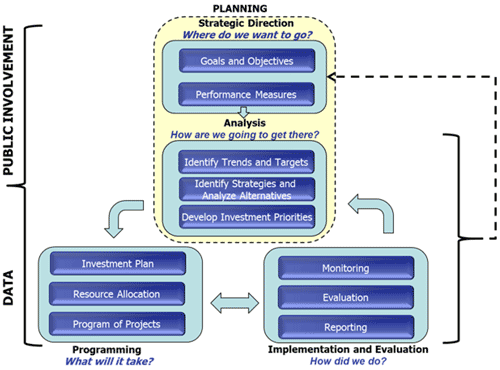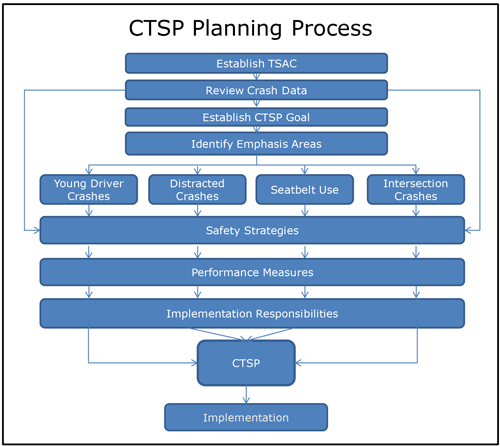
3.0 Performance-Based Planning Processes
A key outcome of this guidebook is to describe how data (crash, roadway characteristics, vehicle miles traveled (VMT), etc.) and the outputs of analysis can be used by planners during the transportation planning processes to develop safety goals, objectives, performance measures, and targets; identify and prioritize projects; and evaluate progress towards safety priorities. States often possess robust safety data, and planners have the skills and tools to analyze an array of crash information to inform safety-specific plans or safety components of transportation plans. However, all too often, data and analysis are not used to inform safety considerations in all transportation decisionmaking and project prioritization.
The basics of the transportation planning process and opportunities to incorporate the outputs of safety analysis into that process are presented in this section. The goal is to help planners develop a performance-based framework for lowering fatalities and serious injuries. This section also provides an overview of SHSPs, describing how they may serve as a resource.
3.1 The Transportation Planning Process
Why is “Data Driven” so Important to the Planning Process?
Transportation programs and projects need to demonstrate how they address the most pressing needs. Data allows planners to develop goals, objectives, performance measures, and targets, and to quantify the impacts of policies, programs, and projects.
Transportation plans come in many different varieties. Long-range transportation plans (LRTP) define an overarching vision for the future transportation system; establish goals and objectives that clarify and operationalize that vision; and guide the selection of transportation policies, programs, and projects consistent with the goals. Modal plans (i.e., bicycle/‌pedestrian, freight) function in the same way as long-range plans, but typically are focused on one transportation topic and identify short-, mid-, and long-term policies, programs, and projects. Corridor plans address a range of transportation topics or modal priorities along a certain portion of the transportation network and also identify short-, mid-, and long-term policies, programs, and projects. Regardless of the type of plan, the ultimate goal is the same—use a performance-based transportation planning process to identify programmatic, policy, and project priorities to address current and future needs. Figure 3.1 outlines a goal-driven process that can be used to construct any transportation planning document.
Figure 3.1 Flowchart. Federal Highway Administration (FHWA) Performance-Based Planning and Programming Framework
Source: FHWA Performance-Based Planning and Programming Guidebook, September 2013.
Agencies may use different terminology or approach performance-based planning in slightly different ways than what is illustrated in figure 3.1, but the core planning tasks often include:
- Data collection and analysis to identify needs, priorities, policies, programs, and projects;
- Goals and objectives to frame those needs and priorities and establish evaluation criteria;
- Performance measures and targets to evaluate alternatives and track progress towards the goals and objectives;
- Project prioritization and programming to identify the mix of projects that meet the goals and objectives of the plan and contribute progress towards the performance target; and
- Evaluation to understand the extent to which safety performance for the transportation system, modes, or behaviors is changing and where future investments can be made.
3.1.1 Data Collection and Analysis
To initiate a planning process, planners obtain data to analyze current and future transportation issues and needs. Traditionally, issues and needs relate to capacity constraints, connectivity gaps, or system preservation. This analysis leads to the identification of goals and objectives, various transportation improvement strategies, and ultimately project priorities and investments to address those needs.
3.1.2 Goals and Objectives
Planners coordinate with stakeholders and the public, and consult data to develop goals and objectives. Goals define a desired result, or outcome, while objectives support the goal by providing additional details, or strategies, on how the goal will be achieved. Goals and objectives provide the framework necessary for planners to identify transportation programs and projects.
3.1.3 Performance Measures and Targets
Performance measures are tied to goals and objectives and are used to assess the effectiveness of programs and projects that address transportation issues and deficiencies (i.e., Will this project/program improve air quality? Will it reduce the number of fatalities? Will it increase person throughput?). Performance targets are a numeric goal and describe the extent to which an agency will address its goals, taking into account resources and funding (i.e., conformity attainment by 2015, 5 percent reduction in fatalities by 2020, 10 percent increase in person throughput by 2025).
3.1.4 Project Prioritization and Programming
Project prioritization is an evaluation process to identify the transportation programs and projects that best support the overall goals and/or objectives of the plan and help an agency make progress towards its performance targets with available resources. Agencies often develop a scoring/ranking methodology and identify evaluation criteria in which to assess the value and costs of transportation projects.
3.1.5 Evaluation
Transportation systems or specific projects can be evaluated to understand the extent to which crashes, fatalities, and/or serious injuries are increasing or decreasing. Many agencies use performance measures and targets to track and then evaluate progress towards programmatic safety goals and objectives. Some may also assess and evaluate the reduction potential for certain projects. Both programmatic and project evaluation provide information on how and where to invest limited resources.
Each of these individual planning tasks builds upon one another to form a framework, or process, for identifying and programming transportation priorities. The next section goes on to discuss how safety can be included during these tasks to lower fatalities and serious injuries.
3.2 The Strategic Highway Safety Planning Process
State DOTs are required to develop Strategic Highway Safety Plans (SHSP) in a cooperative process with Local, State, Federal, Tribal, and other safety stakeholders. This includes regional and metropolitan transportation planning organizations and county transportation officials. It is a data-driven plan that presents a framework for reducing fatalities and serious injuries on all public roads in the State. Each State’s SHSP identifies safety problems, as well as key emphasis areas that direct safety resources for all public roads. For these plans, crash data and analysis must be used to inform selection of safety emphasis areas and strategies. Federal, State, and other funds can be used for efforts that support the priorities and strategies in the SHSP. For example, HSIP funds are applied to projects and initiatives that are consistent with the emphasis areas and strategies found in their State’s SHSP. National Highway Traffic Safety Administration (NHTSA) funds (e.g., Section 402 (23 CFR Part 1200) and 405 (23 CFR Parts 1200.21, 1200.22, 1200.23, 1200.23(5), 1200.24, 1200.25, 1200.26, and 1200.20(e)(3)) also are often used to fund SHSP-related projects, particularly those related to behavioral countermeasures.
The SHSP is intended to be a coordinated planning effort. Legislation encourages coordination of the SHSP with various other planning documents (i.e., Highway Safety Plan (HSP), Commercial Vehicle Safety Plan (CVSP), local plans, etc.) and the LRTP must integrate directly, or by reference, the goals, objectives, performance measures, and targets described in other State transportation plans, such as the SHSP. The SHSP is an extremely useful tool, complimenting and enhancing safety efforts conducted during the transportation planning process. The relationship between the two documents is further described in Section 3.2.1.
3.2.1 The SHSP Data-Driven Planning Process
Funding Safety Plans
In many instances, the DOT will provide funding to MPOs or local jurisdictions to complete safety plans. However, another source of funding can be the State Highway Safety Office. The Cheyenne MPO in Wyoming coordinated with the National Highway Traffic Safety Administration and the Wyoming Highway Safety Office to complete an update to their Safety Management Plan.
The SHSP development and update process can be a model for planners interested in a data-driven approach to identifying safety programs and projects. The SHSP Champion’s Guidebook, Second Edition provides the basic structure for SHSP development, including data collection and analysis; SHSP content (performance measures, goals and objectives, emphasis areas); and SHSP preparation (plan format). State and regional agencies interested in identifying safety priorities; developing safety goals, objectives, and performance measures; and prioritizing safety funding can use this framework when developing regional safety plans, mode-specific safety plans, corridor plans, or integrating safety into other transportation planning documents. This SHSP-style planning approach can be seen in practice in Montana. Six communities developed community transportation safety plans. Figure 3.2 demonstrates the process used to identify emphasis areas, strategies, and performance measures through data and analysis.
Figure 3.2 Flowchart. Planning Process for Montana Safety Plans
Source: Bozeman Community Transportation Safety Plan (CTSP), July 2013.
Although the SHSP is an important tool during the transportation planning process, planners also need to think beyond the contents of the SHSP and consider medium- to longer-term safety considerations during transportation plan development. Section 3.2.2 describes the differences between the two planning processes.
3.2.2 SHSPs and Transportation Plans
A common question asked by transportation planners is, “Why does safety need to be considered in transportation plans when the topic already is strategically addressed in the SHSP?” This should be done because:
- Transportation plans typically look at longer planning horizons than the SHSP and must consider how future infrastructure can be planned safer. To do so, safety is addressed in the LRTP to meet identified safety goals, objectives, and performance measures.
- Transportation planners must consider all modes, corridors, and the network as a whole during the planning process, whereas the SHSP addresses the most pressing and current data-driven safety issues at the statewide level. Planners need to think about the longer-term implications of the emphasis areas outlined in the SHSP, but also need to think beyond those and address topics such as freight, community, and transit safety, as well as other topics that link to safety, such as complete streets, sustainability, health, environment, and more.
- Transportation planning studies are necessary to focus on and pinpoint the range of safety issues, project locations, and countermeasures, beyond what would be expected in the SHSP. Specific projects, funding sources, or locations where safety needs to be addressed would be included in state and metropolitan transportation improvement programs (S/TIPs).
SHSPs assume a data-driven approach to identify goals (or emphasis areas), objectives, strategies, performance measures, and programs/projects. This process does compliment the transportation planning process to help with the identification of data-driven transportation safety priorities in LRTPs, modal plans, or other transportation documents.
3.3 Integrating Safety during the Transportation Planning Process
Why is it Important to Consider Safety in the Transportation Planning Process?
Transportation related fatalities occur every day. Transportation planners have an
inherent responsibility to identify transportation projects and programs to meet safety goals and work towards reducing fatalities and serious injuries to zero.
Planners utilize the transportation planning process as a framework for planning, prioritizing, programming investments, and advancing policies. Incorporating safety into planning does not require an entirely new process—it can be easily integrated into the common tasks that planners already undertake, including data collection and analysis, goal and objective setting, performance measures and targets, project prioritization and programming, and evaluation. Table 3.1 depicts the common transportation planning tasks, the opportunities to consider safety during those tasks, and MPO and State DOT examples of safety integration.
| Transportation Planning Process—Key Planning Task | Safety Integration into Key Planning Task | Examples |
|---|---|---|
| Data Collection and Analysis |
|
|
| Goal and Objective Setting |
|
|
| Performance Measures and Targets |
|
|
| Project Prioritization and Programming |
|
|
| Evaluation |
|
|





